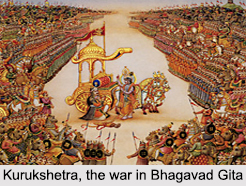 The background of the Bhagavad Gita commences before the initiation of the climactic combat at Kurukshetra. It begins with the Pandava prince Arjuna, as he becomes saturated with doubts on the battleground. Substantiating that his enemies are his own relatives, dearest friends and venerated `gurus`, he turns to his charioteer and guide, Lord Krishna, for advice.
The background of the Bhagavad Gita commences before the initiation of the climactic combat at Kurukshetra. It begins with the Pandava prince Arjuna, as he becomes saturated with doubts on the battleground. Substantiating that his enemies are his own relatives, dearest friends and venerated `gurus`, he turns to his charioteer and guide, Lord Krishna, for advice.
Herein, while being very much present in the battlefield, Arjuna is confounded; the battle is about to begin, with warring parties approaching their positions. King Dhritarashtra, father to the Kauravas, then asked Sanjaya (King Dhritarashtra`s advisor and also his charioteer, who was gifted to `see` events at a distance granted by the rishi Ved Vyas. He narrates to Dhritarashtra the action in the battle of Kurukshetra) what exactly was going by on the sacred battlefield of Kurukshetra, when his (the king`s) people had gathered against the Pandavas. Sanjaya started replying thus that the Prince Duryodhana, when he witnessed the army of the Pandavas parading towards the battleground, approached his preceptor Guru Dronacharya and spoke about the regal line-up to battle of the rival sides.
Duryodhana addressed Dronacharya as his revered father, asking him to behold the mighty host of the Pandavas, paraded by the son of King Drupada, Dronacharya`s wise disciple. In the group were present heroes and great bowmen; the equals in battle of Arjuna and Bhima, Yuyudhana, Virata and Drupada, who were also valiant soldiers. Bhagavad Gita`s background was started rather in a sad note, with brothers and first blood preparing themselves to battle out each other`s supremacy for winning the royal throne. In the Pandava group were also present Dhrishtaketu, Chekitan, the gallant King of Benaras, Purujit, Kuntibhoja, Shaibya, Yudhamanyu, Uttamouja, Soubhadra and the sons of Draupadi, all legendary men.
Duryodhana then requested Dronacharya to further take note of all those captains who had ranged themselves on their side, the best of spiritual guides, the leaders of his army. The charismatic line-up of the Kauravas consisted of Bhishma, Kama, Kripa, all great soldiers, accompanied by Ashwaththama, Vikarna and the son of Somadatta. There were many others, described by Duryodhana, who were all ready to die for his sake, all armed, all skilled in war. Yet, he was filled with apprehension that his army seemed the weaker, though commanded by Bhishma. He spoke thus with extreme uncertainty that the Pandavas` army seemed the stronger, though commanded by Bhima. Thus, equipped with his own rank and file, Duryodhana wished to let all stand firm in their posts, according to battalions and ordered each of his generals to turn to Bhishma.`
The background of Bhagavad Gita is narrated further, which enunciates that to enliven his spirits, the brave Grandfather Bhishma, eldest of the Kuru (Kaurava)-clan, blew his conch, till it reverberated like a lion`s roar. And rightaway all the conches and drums, the trumpets and horns, blared forth in tumultuous uproar.
At this point, seated in their spacious war-chariot, yoked with white horses, Lord Krishna and Arjuna sounded their divine shells. Shri Krishna blew his Panchajanya (Krishna`s conch-shell) and Arjuna his Devadatta (Arjuna`s conch-shell), followed by brave Bhima with his renowned conch-shell, Poundra. The King Dharmaraja, the son of Kunti, Yudhisthir blew the Anantavijaya (Yudhisthir`s conch-shell) Nakula and Sahadeva, their Sughosh and Manipushpaka respectively. The Maharaja of Benaras the great archer, Shikhandi the great soldier, Dhrishtadyumna, Virata and Satyaki the invincible blew up their conches to herald the legendary war of Kurukshetra. Drupada, the sons of Draupadi, and Soubhadra the great soldier, blew their conches too. The tumult thus ensued, rent the hearts of the sons of Dhritarashtra and violently shook heaven and earth with its echo.
 Then beholding the sons of Dhritarashtra, drawn up on the battlefield, ready to begin the fight, Arjuna, whose flag bore the Hanuman, spoke thus to Krishna by raising his bow: `O Infallible! Lord of the earth! please draw up my chariot betwixt the two armies, so that I may observe those who must fight on my side, those who must fight against me; `And gaze over this array of soldiers, eager to please the sinful son of Dhritarashtra.`
Then beholding the sons of Dhritarashtra, drawn up on the battlefield, ready to begin the fight, Arjuna, whose flag bore the Hanuman, spoke thus to Krishna by raising his bow: `O Infallible! Lord of the earth! please draw up my chariot betwixt the two armies, so that I may observe those who must fight on my side, those who must fight against me; `And gaze over this array of soldiers, eager to please the sinful son of Dhritarashtra.`
Sanjaya, in the meantime was continuing with his narration to Dhritarashtra concerning the priceless background of Bhagavad Gita. He replied that having listened to the request of Arjuna, Lord Krishna drew up his bright chariot exactly in the midst between the two armies. From that position, where Arjuna had assembled, Bhishma and Dronacharya had led all the rulers of the earth and spoke in a heartfelt tone requesting Arjuna to behold the members of the family of Kauravas assembled. There, Arjuna noticed fathers, grandfathers, uncles, cousins, sons, grandsons, teachers, friends, fathers-in-law and benefactors, aligned on both sides. He just gazed at all those kinsmen before him. And his heart melted with pity and sadly he blurted out that when he witnesses all these, his own people, thirsting for battle, his limbs fail him and makes his throat parched, his body tremble and hair stand at their end. Arjuna went on further to painfully utter that his bow Gandeeva slips from his hand and makes his skin burn. He was in such a state of dichotomy and distress that it was hard for him to keep quiet, his mind being in a state of tumult.
The mighty Arjuna`s wailing amidst such a position, when a forceful battle was about to begin, in which he was to embark and take centre-stage, was highly unlikely. Lord Krishna`s pacifying discourses made up for a soothing balm, as a background to Bhagavad Gita. Arjuna, meanwhile, continued that the omens in the war were extremely adverse, as no good could come from the slaughter of his people on the battlefield. The third Pandava addressed to Bhishma and Dronacharya that he was craving not for victory, nor for kingdom, nor for any pleasure. A mere kingdom or happiness or life to him mattered nothing, when those for whose sake he desired these things stood there about to sacrifice their property and their lives. He vowed not to kill them, even for the three worlds. It matters nothing to Arjuna if, in the ensuing war he himself would be slain.
Happiness would never arrive from the death of the sons of Dhritarashtra. According to Arjuna, in the process, they would only invite in sin, if they slay the desperate cousins. Arjuna continued that they were worthy of a much nobler feat than to slaughter their own relatives, the sons of Dhritarashtra. Although Arjuna lamented that his cousins, blinded by greed, saw no guilt in destroying their kin, or fighting against their friends, it was their wise duty to make their cousins take a more thoughtful and rightful turn. As Arjuna went on in his elucidation, he spoke that the destruction of their kindred meant the destruction of the traditions of their ancient lineage. If and when these were lost, irreligion would indefinitely overrun their homes. By the destruction of their lineage and the pollution of blood, ancient class traditions and family purity, alike perish.
Arjuna`s lamentation served as a substantial prelude for background of Bhagavad Gita, after which Krishna charted his cardinal discourses. However, for Arjuna, nothing mattered more than his family and first blood at the present moment. He felt it exceedingly strange that they should be willing to kill their own countrymen and commit a great sin, in order to enjoy the pleasures of a kingdom. On the contrary, if the sons of Dhritarashtra, with weapons in their hands, should choose to slay Arjuna, unarmed and unresisting, he would lay down his life heartily.
Sanjaya, having finished his narration to Dhritarashtra of the introductory phase of Kurukshetra, spoke that, in the midst of the armies, Arjuna sank on the seat of the chariot, casting away his bow and arrow, heartbroken with grief.



















